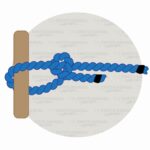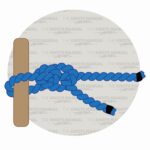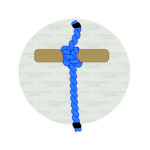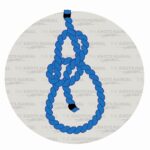A knot is a structure made on a length of rope by twisting the rope around itself. Knots often bind the rope to itself or other objects.
Knots are necessary whenever you use rope, but they lessen the rope’s strength. How much a knot reduces the strength depends on three factors:
- The rope’s material
- The type of knot created
- The load placed on the rope.
Even if we don’t realize it, we use knots every day when we tie our shoes, wear a hair tie, or just wear clothing. Knots are also popular among hobbyists who do outdoor activities. Camping, climbing, and spelunking all require the use of knots. Knots are famous among crafters for creating intricate designs perfect for home decorating.
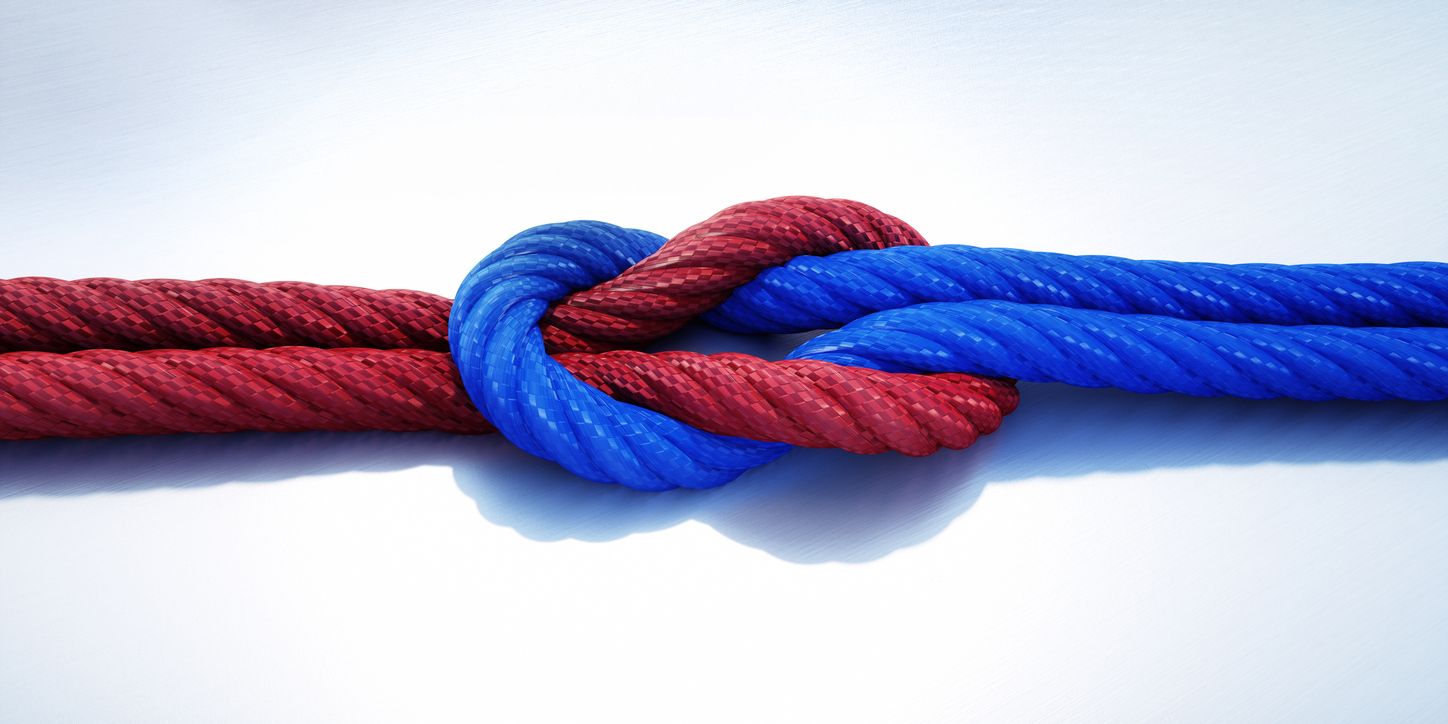
Knots have a rich history that dates back at least 15-17,000 years. Ancient humans used knots before axes and wheels. They also used knots to create fishing nets and to tie things. Some historians think gorillas used knots long before we did.
Knots don’t always have practical uses. Sometimes, they are meant only for symbolism and decoration. The Celts are famous for their beautiful artwork depicting knots, as are the Chinese.
You first need to understand the terminology to learn how to create knots. Once you know the parts of knots and rope, you can begin making basic knots.
What Is A Knot?
A knot is the placing of rope parts within themselves to bind objects together. Knots come from one or more ropes, cords, or other flexible materials. Essentially, a knot is a type of knob created within a rope. A knot may also refer to a knob at the end of a rope that keeps the end from slipping through an eye. You create a knot by turning the rope on itself to create a loop.
There are three basic kinds of knots:
Overhand Knot: a knot turned in on itself to create a loop.
Hitch: a knot used to attach a rope to another object, like a pole.
Bend: a knot used to fasten a rope to another rope.
For a knot to be considered “good,” you should be able to tie and untie it with ease, and the knot should not slip. The principal purpose of a knot is that when you pull on the ends of the rope, the knot becomes tighter. The friction within the knot parts allows the knot to hold securely.
What Do We Use Knots For?
Knots have three main uses:
- To attach a rope to another object like a cleat, ring, stake, pole, or another rope
- To bind objects
- For decoration — decorative knots usually bind themselves to create patterns
Teaching
The most basic use of knots is to teach others how to create knots. You may need help learning complicated knots.
Many outdoor programs teach knot-tying so that people of all ages can learn the hands-on skill. Knot-tying is an essential skill for those participating in any outdoor activity.
Outdoor Activities
Those who take part in outdoor activities need to tie knots:
- Sailors
- Campers
- Hikers
- Mountainers
- Scouts
- Canyoners
- Cavers
- Fishermen
Activities like sailing, climbing, and spelunking are dangerous. Participants must know how to create life-saving knots.
For instance, a climber may fall into a ravine and injure themselves. A rope and a well-tied knot can save their life. Another climber uses knots to rappel into the ravine to reach the injured person. Then, they can use other knots to create a hauling system to lift the injured person out of the ravine.
Medical Use
Knots are essential in medicine, especially for suturing the body after surgery.
Theater
Ropes and knots are also necessary in the theater world. Theater technicians use knots to bring the large curtains and props to life. Secure knots allow the large stage curtains to move back and forth from the stage. They also secure props, so the actors feel safe while on stage.
Other Professionals
Some professionals use ropes, such as construction workers, linemen, truckers, fishermen, and arborists. Knots not only make their jobs easier, but they make them safer. For instance, arborists use timber hitches to tie around trees they need to tear down. To tear down trees, they use ropes and knots that are more flexible, so they don’t snap. They use ropes and knots that are more rigid to climb trees so they don’t fall.
Decoration
Using knots to create decorative items has been practiced since ancient times. Macrame, in particular, has been gaining popularity over the past few years. Macrame is an art form in which people twist natural rope fibers into knots. The result is both decorative and practical items. Macrame crafters often create things like hanging planters and shelves.
How Strong Are Knots?
Knots weaken ropes. When rope fails, it usually fails at or near the knot due to too much strain. Knots stay in place due to a combination of friction, crushing, and bending. All these forces weaken the rope by exerting uneven stress across the length of the rope.
Knot efficiency refers to how strong a knotted rope is versus how strong it would be unknotted. It determines how much strain a knotted rope can take before breaking. Determining the knot efficiency is difficult because you must factor in several things.
First, the type of fiber that comprises the rope determines strength. Second, whether the rope is braided, plaited, or twisted determines how strong the rope will be. Thirdly, you must consider the length and width of the rope. Fourth, consider whether the rope is wet or dry: moisture weakens ropes. Lastly, rope weakens depending on how it was dressed before loading and how quickly it was loaded.
Most knots lower the efficiency of a rope by 40-80% of the rope’s original strength.
Potential Problems With Knots
Slipping occurs if you tie a load to your rope. It creates tension, pulling on the rope in the direction of the load. A load that is heavy enough and a knot that is weak enough can cause the knot to unravel.
Capsizing occurs when you pull on the ends in a way that causes the knot to change form. Some knots, like the carrick bend, are capsized intentionally. Intentional capsizing creates a stronger structure. Unintentional capsizing leaves a knot more susceptible to slipping.
Sliding refers to a knot slipping from the object it is tied to. Ropes are usually tied to things to grip and make them more secure. A sliding knot no longer grips the object properly.
Jamming refers to knots that are difficult to untie. One of the essential qualities of a good knot is that it’s easy to undo. A “jamming knot” is a knot that is difficult to untie, while a “non-jamming knot” is easy to untie.
What Is Knotting?
Knotting is the act of tying knots in yarn or string. You can use the knots to create decorative designs and items like carpets. “Knotting” describes decorative knot tying. It doesn’t describe the creation of knots for practical uses. Examples of knotting include macrame and tatting.
What Is The History Of Knots?
Some historians believe that knot-tying may have begun before humans walked the earth. They say intelligent gorillas may have been the first knotters. They knew how to create simple granny knots with branches to construct their nests.
Rope — An Ancient Tool
Knot-tying has been around since early human history. We began creating tools with rope. The creation of knots predates other simple tools like axes and the wheel. Some historians think knot-tying may even predate the discovery of fire.
The oldest fossil records of ropes are from 13,000 BC, about 15,000-17,000 years ago. Historians believe ancient peoples used knots long before that, but that we don’t have a record of it.
Ancient people began using knots to tie stone heads onto wood to create primitive axes. Ancient peoples also began tying knots into ropes to make nets for fishing and hunting traps.
There are 19 knots that ancient humans created:
- Bottle sling knot
- Bowline knot
- Cat’s paw knot
- Clove hitch
- Double fisherman’s knot
- Eskimo bowline knot
- Figure-eight knot
- Fisherman’s knot
- Half hitch
- Kalmyk loop
- One-sided overhand bend
- Overhand knot
- Overhand loop
- Reef knot
- Running bowline knot
- Single hitch
- Theif knot
- Turk’s head knot
- Two half hitches
Around 8000-6500 BC, people began using knots to create garments from textiles. Before then, people made clothes by sewing animal skins together.
The Egyptians created a rope-making spindle around 4000 BC.
In 218 BC, the Romans used rope to sling bolts at their enemies during the Second Punic War.
Chinese knotting has been around since the Tang and Song Dynasties from 960-1279 AD. Decorative Chinses knotting, a type of folk art, later became more popular in the Ming dynasty.
Chinese knotting includes eleven basic kinds of knots:
- Four-flower knot
- Six-flower knot
- Chinese button knot
- Double connection knot
- Double coin knot
- Agemaki knot
- Cross knot
- Square knot
- Plafond knot
- Pan Chang knot
- Good luck knot
Around 1200 AD, Arabs began using knots to decorate the edges of their textiles. The practice soon made its way to Spain.
In the 1400s, the Incas recorded important records with knots on devices called “quipu.”
In the 1500s, early Europeans began creating ropewalks. Ropewalks are long, narrow buildings where they could twist rope.
In the 1600s, decorative macrame came to the English court of Queen Mary the Second.
Sailing — A Knotting Revolution
Knot-making majorly influenced human history around the 1800s. it was at this time that we learned to use knots to sail boats. Early humans used knots to rig their vessels to control the sails. Doing this offered safer and more controlled sailing.
For the longest period of knot-making history, knots were considered a sailor’s tool. Sailors were excellent crafters of knots. They were continually inventing new and better knots to use on their ships. Sailors crafted many of the knots we still use today. The bowline knot was the most popular knot used by sailors to tie up their boats. The bowline knot dates back to the ancient Egyptians.
Sailors also practiced coxcombing. Coxcombing is a form of decorative knotwork that goes on items around the ship. The purpose of coxcombing was to protect, decorate, or identify specific objects. Coxcombing is less common today. Still, some boaters still decorate their tillers, wheels, and rudders.
Coxcombing knots included:
- Turk’s head knot
- Flemish knot
- French whipping knot
Modern Knot Usage
Today, we do not use knots as much on boats and ships. Sails were largely replaced by steam-powered engines. Recreational sailors still use knots heavily on their vessels.
Although we don’t use knots on ships as often, knots are still as important today as they ever were. We use knots in everyday life, from tying our shoes to tying a bow to place on a present.
You likely use knots every day without realizing it:
- Neckties
- Hair ties
- Braided hair
- Knitted sweaters
- Sewn garments like shirts, pants, & underwear
Those who enjoy the outdoors use ropes for camping, hiking, mountaineering, and fishing. Knots are great for crafting — people create baskets, rugs, and decorative pieces. Strong knots are also essential for industrial use.
Knot Meaning — Across Cultures
Tying knots is not just for practical purposes. Knots have significant meaning across cultures worldwide.
Celtic Knots
Knots are rooted in ancient Celtic symbolism; the Celtic knot is one of the most famous knots in history. Knots were important in Celtic culture before the influence of Christianity. The presence of knots increased with the introduction of Christianity around 450 AD. The Book of Kells is one of the most famous examples. It is a manuscript depicting ancient knot artwork on the cover.
The Trinity Knot (the Triquetra) is a variation of the Celtic knot. It consists of three sections and is formed by a single, continuous line. It symbolizes the importance of the number “three” in Celtic culture. Sacred things came in sequences of threes: the phases of the moon, pregnancy, and birth, life, and death.
The Celtic cross originally represented the sun god. The introduction of Christianity changed its symbolism. It began to signify Jesus Christ and his crucifixion.
“Tie The Knot” Meaning
When people get married, we often say they are “tying the knot.” Tying the knot comes from a tradition where newlywed couples tie their hands together in a knot. The tradition symbolizes their new bond.
The ancient Celts practiced the “handfasting ceremony.” The couple would hold hands while another person bound their hands with a bit of ribbon or cord. Couples sometimes choose a specific color for their ribbon because of symbolization. For instance, a blue ribbon symbolizes patience, devotion, sincerity, and tranquility.
Ancient Egypt
Ancient Egyptians regarded knots as a symbol of connection and represented “infinity.” It symbolized the eternal life of their gods and those who were good in life.
China
The Chinese recognize knots as symbols of good luck, and that good things would be coming to them in their lives. Knots were often used to ward off bad luck, thus allowing good fortune to come their way. Knots were seen as a form of protection and liberation.
The color of the knot also holds important meaning to the Chinese. For instance, red knots symbolize good fortune.
Like the Celts, knots are important for Chinese wedding ceremonies. The “true love knot” and “double happiness knot” often appear at Chinese weddings. Lovers often give these knots to their significant other as a token of their love.
Important Rope & Knot Terminology
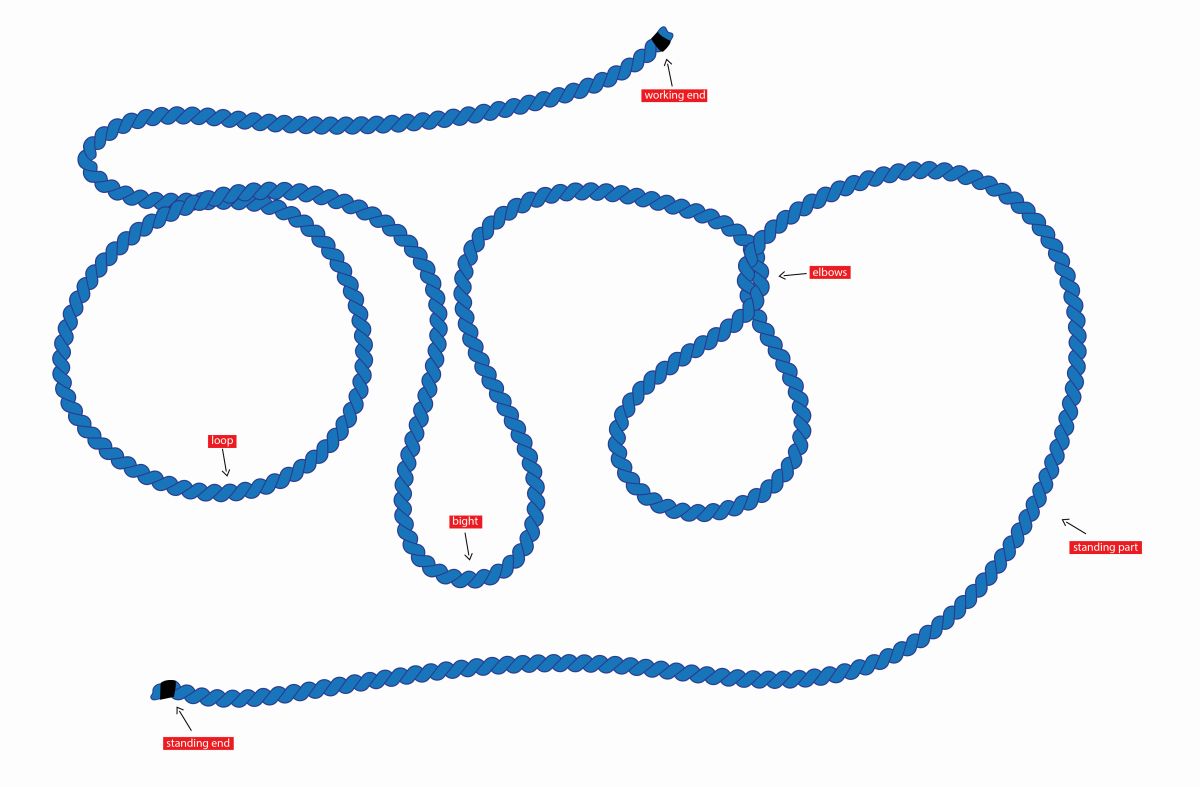
The Working End is the end of the rope that you use to create a knot.
The Working Part is the area of rope between the working end and the knot.
The Standing End is the end of the rope not actively used to create the knot. It is often the end of the rope used to tie to a load.
A Bight is any slack, loop, or curved part of rope between the working and standing ends.
A Loop is a curve with separate ends narrower than a bight.
An Elbow comes from putting an extra twist in a loop, creating two crossing points.
A Single Turn is a curve in the rope where the legs cross. A Round Turn is when a rope completely encircles an object, requiring two passes. Two Round Turns are when the rope completely wraps an object twice. It requires three passes.
Examples Of Basic Knots
Tying a knot in rope can be easy or complex, depending on the type of knot. Here are 14 of the most common types of knots.
Overhand Knot
An overhand knot is the simplest knot. First, cross the working end over the standing end to form a loop. Second, thread the working end through the rope. Thirdly, pull the ends tight.
You can use overhand knots to tie your shoes, tie packages, or keep fraying ropes together. Overhand knots also make up the basis of more complex knots like the surgeon’s or square knot.
Slipknot
A slipknot is a type of overhand knot. You won’t thread the working end of the rope through the loop. Instead, you’ll thread another loop of rope through the original loop.
Shoelaces are often tied with a double slipknot.
Binding Knot
A binding knot is wound around an object many times to restrict it. A whipping knot is a type of binding knot that prevents lines from fraying.
Lashing
A lashing knot holds objects together, usually poles.
Square Knot
You create a square knot with two overhand knots that you turn in opposite directions. When you pull a square knot tight, it flattens. Its shape makes it suitable for tying packages, scarves, and first aid uses. Square knots are not strong structures, so you should use them for heavy loads.
Half Hitch
A half hitch is a variation of the overhand knot and is the simplest kind of hitch. Pass the working end around the standing part and through the loop to make a half hitch. Unlike a regular overhand knot, a half hitch’s loop forms around an object like a pole.
To create a double half hitch, create a second half hitch around the rope’s standing end. You can use double half hitches to secure the end of the rope to itself. Double half hitches are common on boats for use on rings, moorings, or pilings.
Taut-Line Hitch
A taut-line hitch is like two half hitches. You can use it to tie around poles, as it is an adjustable loop-knot hitch. Unlike two half hitches, a taut-line hitch won’t slip when you apply tension. These hitches are suitable for stringing hammocks or tying a load to your car.
Bowline
Bowline knots are classic, simple knots. You can use a bowline knot to tie an object to a tree or when you need to pull a person or object. A bowline has a loop at the end of the line with a fixed knot. The knot does not slip regardless of the weight of the load.
Sheet Bend
A sheet bend joins two ropes and is good for heavy loads because it won’t slip when you apply heavy tension.
Seizing Knot
A seizing knot holds two lines together or two parts of the same line.
Stopper Knot
A stopper knot holds a line through a hole.
Timber Hitch
Loggers use timber hitches to tie ropes to tree trunks. Timber hitches are practical because they are quick to tie and untie. You create a timber hitch by turning the rope back on itself three or more times.
Loop Knot
Any knot that creates a loop.
Splice
Any kind of multi-strand knot; includes bends and loops.
FAQs
What Are “Knots” In Your Muscles?
A “knot” in your muscle refers to a tender or painful spot common in the back and legs. The name “knot” makes it sound like your muscles are twisting. Knots are really muscle spasms that cause your muscles to tighten.
What Is A “Knot” In Boating?
In boating, a “knot” is a measure of speed equal to “one nautical mile per hour.” One nautical mile equals 1.15 miles or 1.85 kilometers. So, 1 knot equals 1.15 mph or 1.85 k/mh.
The term “knot” came from 17th-century sailors. They measured their ship’s speed using a “common log.” A common log was a rope coil with knots placed at uniform distances. Sailors tied the rope to a log that floated behind the back of the ship. When a crewman dropped the piece of wood, they would allow the rope to uncoil for a certain amount of time. Then, they would pull the rope in and count how many knots had left the ship.
What Is A “Knot” In A Tree?
A “knot” in a tree is not really a knot but an imperfection in the wood. We call them knots because they are usually circular-shaped and darker than the rest of the tree. Their composition resembles knots in rope. Sometimes, the knot falls from the tree, forming a hole inside the tree called a “knothole.” The knot that falls from the tree even more closely resembles a knot in a piece of rope.
